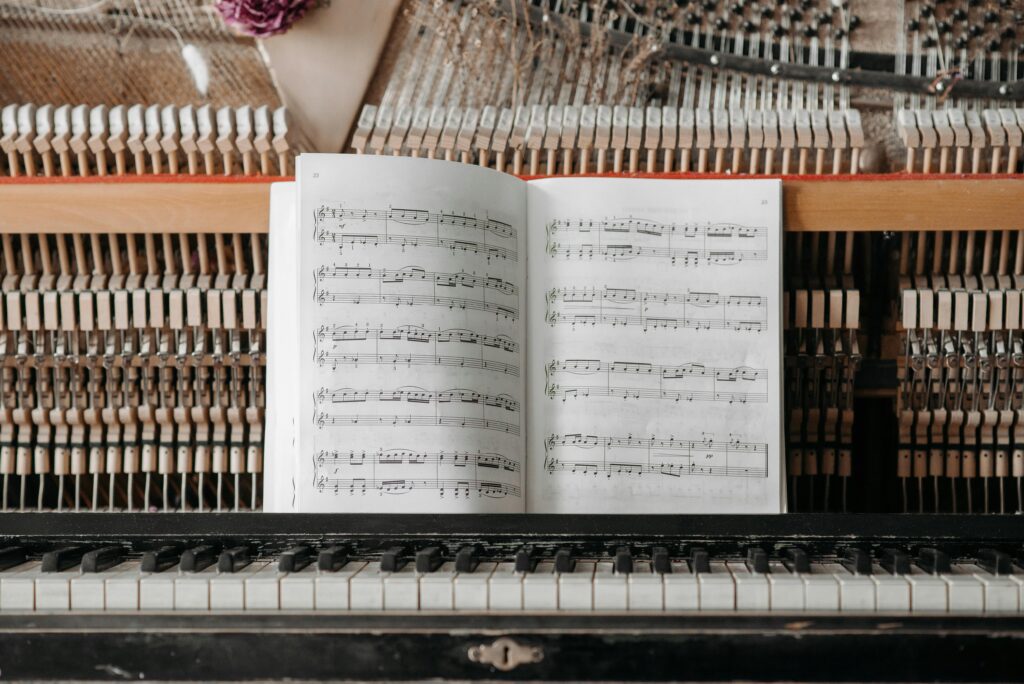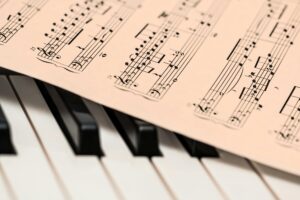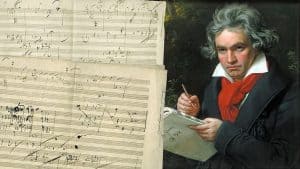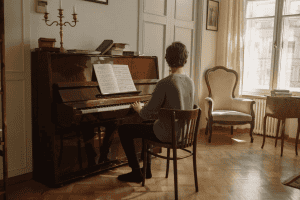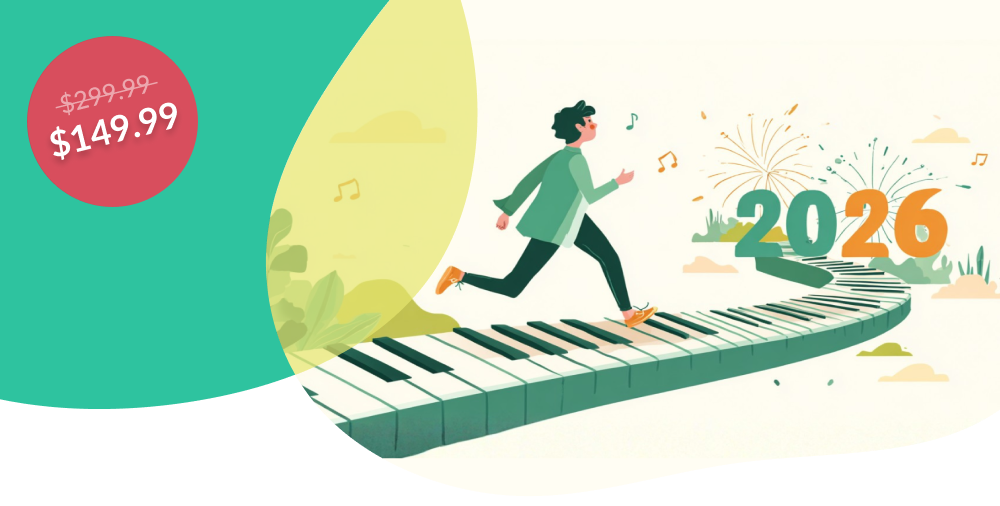The piano sonata has long been a cornerstone of classical music, offering profound emotional depth and technical complexity. For pianists, the classical sonata present both a demanding challenge and a chance for deep artistic expression. Over the centuries, composers have shaped and evolved this form, creating timeless masterpieces.
In this article, we’ll dive into the top 7 best sonatas of all time that have left a lasting impact on music, inspiring generations of musicians and audiences across the world.
- Fall in love with the music - Learn your favorite songs, at a level suitable for you.
- Enjoy interactive piano lessons - Explore courses covering music theory, technique chords & more.
- Get real-time feedback - Skoove's feedback tells you what went well and what needs practice.

Beethoven – Piano Sonata No. 14 “Moonlight Sonata”
Composed in 1801, Beethoven’s “Moonlight Sonata” is one of the most famous piano sonatas ever written and is a popular starting point for pianists exploring classical music.
Beethoven was profoundly deaf when he composed this piece, making his hauntingly lyrical first movement all the more remarkable. The sonata’s nickname, “Moonlight,” was given after Beethoven’s death due to its dreamy and mysterious quality, particularly in the Adagio sostenuto opening movement.
The serene opening contrasts sharply with the stormy, dramatic third movement, Presto agitato. Interpreting its emotional depth while navigating the technical demands makes it a favorite among performers and listeners alike.
Mozart – Piano Sonata No. 11 “Alla Turca”
Mozart composed his Piano Sonata No. 11 in A Major in 1783, best known for its lively final movement, “Rondo Alla Turca” which is often performed as a stand-alone piece. The “Alla Turca” mimics the sound of Turkish Janissary bands popular in Vienna at the time, giving it its popular name the ‘Turkish March’.
One of his most famous sonatas, this piece showcases Mozart’s blend of charm and technical skill. Though lighter in mood than Beethoven’s works, the sonata remains challenging, especially with the fast, rhythmic patterns of “Alla Turca” making it a favorite among intermediate to advanced pianists.
Beethoven – Piano Sonata No. 8 “Pathétique”
Beethoven composed his “Pathétique” Sonata in 1798. This sonata is famous for its emotional depth, particularly in the first movement which is marked by powerful chords and stark contrasts in dynamics. The slower second movement offers a more introspective and lyrical respite, often regarded as one of Beethoven’s most beautiful melodies.
Mastering the “Pathétique” requires careful attention to the emotional shifts, as well as technical finesse in the rapid passages of the Allegro movements.
Chopin – Piano Sonata No. 2 in B-flat Minor “Funeral March”
Chopin’s Piano Sonata No. 2, composed in 1839, is perhaps best known for its third movement, the “Funeral March.” However, this sonata offers much more than its famous middle section.
Its first and fourth movements are filled with rapid, virtuosic passages that push the pianist’s technical abilities to their limits. The sonata’s contrasting moods make it one of Chopin’s most complex and emotionally charged works.
Pianists must carefully balance the intense technical demands with the emotional weight of the piece, particularly in the Funeral March movement, which requires a steady, solemn tempo and precise articulation to evoke its sense of grief and solemnity.
Mozart – “Sonata Facile“
Mozart’s Sonata No. 16 in C Major, K. 545, “Sonata Facile”, is usually one of the first Mozart pieces beginner piano players learn. It’s bright, elegant and can sound effortless. However, playing it well requires finesse and practice.
The three movements of this sonata demonstrate great contrast and are a great way to practice your playing. The first movement is playful and full of life with bouncy phrasing. The second movement slows things down, bringing a gentle melody that requires smooth expression and careful consideration. The final movement picks up the energy again with a more light hearted energetic feel with a demand on the players agility and control.
This sonata may seem simple at first but will no doubt be a rewarding piece to learn with its beautiful melodies and distinct character.
Beethoven – “Sonata Tempest“
Beethoven’s Piano Sonata No. 17 in D Minor, Op. 31, No. 2, “The Tempest” is an emotionally charged piece full of mystery and power.
The first movement reflects the moment before a storm, full of feelings of hesitation and anticipation. This mood is then broken with a flurry of fast, intense arpeggios – constantly breaking and reforming like waves in a storm. The second movement, the eye of the storm, offers a moment of peace with beautiful melodies contrasting the previous tumult of the earlier section. This tranquility is broken by the final movement which races along with a restless and almost hypnotic motion.
This sonata is like a musical tempest powerful and full of raw emotion. A perfect example of Beethoven’s genius and a perfect piece to learn on piano!
Mozart – “Sonata no. 11”
Mozart’s Sonata No. 11 in A Major, K. 331 is famous for its final movement, “Rondo alla Turca,” however the whole sonata is filled with variety and charm and we think it deserves a mention on this list.
In the first movement Mozart takes a simple, elegant melody and transforms, sometimes playful, sometimes delicate, sometimes dramatic demonstrating the variety of this sonata in a beautiful exposition. A Minuet and Trio, the second movement, brings a graceful, waltz-like feel, with flowing phrasing and a sense of elegance. Then, the star of the show the previously mentioned “Rondo alla Turca”. Inspired by Turkish Janissary music, full of rapid, percussive rhythms and staccato phrasing.
This sonata is a three act performance with each section showcasing a different side of Mozart’s musical personality. A wonderful mix of elegance, excitement and creativity the perfect piece for any pianist to showcase their love of music.
Mastering piano sonatas with confidence: tips you’ll love
Playing the greatest piano sonatas can be a rewarding but challenging experience for any pianist. From the lyrical beauty of Mozart’s works to the thunderous intensity of Beethoven’s, each sonata presents its own set of technical and interpretative demands. Here are some tips for mastering them:
- Understand the Structure: Sonata form isn’t just a theoretical concept – it’s a roadmap that helps us navigate a piece. When I studied Mozart’s Sonata in C Major, K. 545, understanding its exposition, development, and recapitulation gave me a clearer sense of direction and phrasing.
- Break it Down: When I first tackled Beethoven’s Pathetique Sonata, I quickly learned that trying to play it all at once was overwhelming. Instead, I focused on one movement, or even one phrase, at a time. This method not only made the piece more manageable but also helped me understand its nuances and intricacies of this famous sonata more deeply .
- Slow Practice is Your Best Friend: It’s tempting to rush through fast passages, but slow practice is where real mastery happens. “If you can play it slowly with control, speed will come naturally” This approach is particularly useful in virtuosic sections, such as the fiery final movement of Moonlight Sonata.
- Embrace the Dynamics: Sonatas are full of emotional contrasts. When I play Chopin’s Funeral March, I think about the contrast between each dynamic change: how a whispering pianissimo can create suspense, or how a sudden fortissimo can feel like a sudden outburst of emotion. Paying attention to these details transforms a performance from mechanical to truly expressive.
- Maintain Good Technique: The best sonata can demand a lot from our hands, fast runs, leaps and expressive phrasing. Proper hand positioning and posture are crucial. Relaxation and efficient finger movement make all the difference.
At the end of the day, mastering a piano sonata isn’t just about technical precision, it’s about making the music your own. As I always say, “Sheet music isn’t just notes on a page; it’s a conversation between you and the composer. Find your voice in it.”
Conclusion
Piano sonatas have captivated audiences since their conception. These compositions, ranging from Mozart’s elegant and amusing pieces to Beethoven’s fervent and turbulent works, offer a profound examination of the piano’s potential.
Learning a piano sonata is a journey that requires both technical proficiency and emotional expressiveness from pianists. They are both rewarding to learn and an impressive showcase of your love for piano. With step-by-step lessons Skoove can help you learn, whether you’re a beginner or more advanced player. Let piano sonatas inspire and advance you along musical journey as you immerse yourself in these iconic classic pieces. Happy practicing!
Author of this blog post:
Susana Pérez Posada

With over seven years of piano education and a deep passion for music therapy, Susana brings a unique blend of expertise to Skoove. A graduate in Music Therapy from SRH Hochschule Heidelberg and an experienced classical pianist from Universidad EAFIT, she infuses her teaching with a holistic approach that transcends traditional piano lessons. Susana’s writings for Skoove combine her rich musical knowledge with engaging storytelling, enriching the learning experience for pianists of all levels. Away from the piano, she loves exploring new places and immersing herself in a good book, believing these diverse experiences enhance her creative teaching style.
Published by Lydia Ogn from the Skoove team







